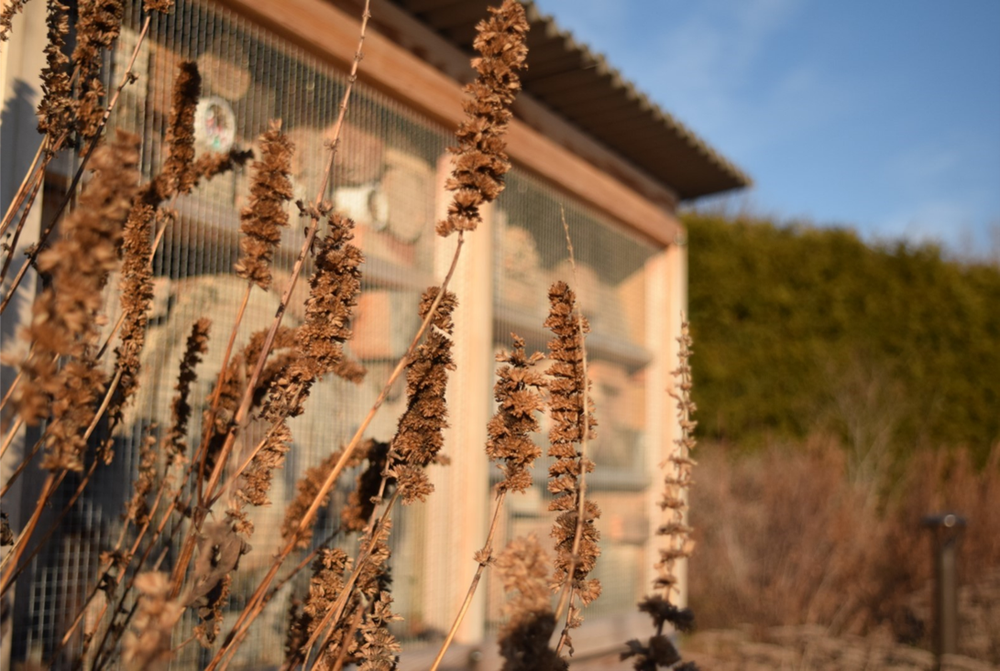Posted: February 4, 2022
IBC Education Progam Specialist Heather Desorcie reports on the use of, and visitors to, the bee hotels recently installed at the PSU Arboretum's Pollinator and Bird Garden

Dried giant hyssop in front of the bee hotels
On visits to the Pollinator and Bird Garden in 2021, I often engaged with visitors standing at the wild bee hotels. People leaned over the giant hyssop (Agastache 'Black Adder') and purple coneflower (Echinacea purpurea) to examine at the bees as they gather pollen and nectar for their young. When you visit to The Arboretum at Penn State this spring, take a moment observe the residents of the hotels. The bees are almost constantly moving in and out of the hollow straws and wooden blocks. These bee hotels have introduced people of all ages to the amazing lives of solitary bees.
Bee hotels approximate natural nesting sites for cavity-nesting solitary bees such as mason bees (Osmia spp.) and leafcutter bees (Megachile spp.). Unlike social species such as honey bees (Apis spp.) or bumble bees (Bombus spp.), cavity-nesting solitary bees do not live or reproduce in a hive. Rather, they seek out dead wood or hollow stems in which they lay their eggs. Unsurprisingly, these nest resources are often removed from edge forests and are absent in urban areas. This creates a challenge for bee communities, since nearly 30% of our native bee species are wood and stem nesters.
Building a bee hotel is a simple way to support bees. They require less intensive management than a honey bee colony. Solitary bee hotels should be cleaned every couple of years to reduce parasites and disease. Also, bee hotel owners are encouraged to provide a diversity of floral resources that bloom for their entire nesting season, from early spring to late summer. Female solitary bees provision their nests with pollen which provides protein, fats and other nutrients to their developing offspring. More information on bee hotel management.
Even in the garden’s first year, the wild bee hotels are being used. Exactly 369 tubes are occupied from the 2021 nesting season. Insect Biodiversity Fellow Codey Mathis, who is working in the garden as part of her doctoral thesis, saw four bee species take up residence in the hotels last year: Giant Resin Bees (Megachile sculpturalis), Eastern Carpenter Bees (Xylocopa virginica), Oblong Woolcarder Bees (Anthidium oblongatum), and European Wool Carder Bees (Anthidium manicatum).
Forty-one other solitary, cavity-nesting species and parasitic species of bees were observed by Mathis in 2021 on flowers in the garden and could possibly be nesting in the wild bee hotels. We will have to wait for the bees to emerge this spring to get a complete list of the species occupying the hotels. Despite the lack of activity during the cold months, the hotels remind us that bees are present in the garden year-round, even if we cannot see them.
The Arboretum at Penn State will be offering programs related to the bee hotels in 2022, including a workshop for participants to construct a bee hotel and learn the basics of managing it. This spring we will be closely monitoring the bee hotels and hosting informal drop-in programs for the public to witness the bees’ emergence. We hope that these educational opportunities will inspire and support those who wish to manage their own bee hotels.
The solitary bee hotels have been a wonderful tool to connect the importance of pollination services and our responsibility to support natural systems. Visit the Pollinator and Bird Garden at The Arboretum at Penn State, which is free and open daily from dawn to dusk. Stay up to date on future programs by subscribing to The Arboretum at Penn State’s newsletter at https://bit.ly/3s5ceIT.

